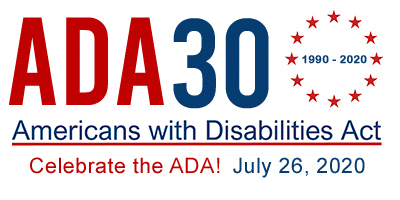 One in five Americans has some type of disability and could become a victim of discrimination. With the goal of eliminating this type of discrimination, Congress enacted the Americans with Disabilities Act on July 26, 1990.
One in five Americans has some type of disability and could become a victim of discrimination. With the goal of eliminating this type of discrimination, Congress enacted the Americans with Disabilities Act on July 26, 1990.
The history of different, separate, and unequal treatment of persons with disabilities could hardly be clearer….The Americans with Disabilities Act is a plenary civil rights statute designed to halt all practices that segregate persons with disabilities and those that treat them inferior or differently. By enacting the ADA, we are making a conscious decision to reverse a sad legacy of segregation and degradation.
– Rep. Ron Dellums (D.- Calif.) (Brief Amicus Curiae of the National Council on Disability in Support of Respondents Olmstead v. L.C. HTM)
The ADA makes it a violation of federal law to discriminate against people with disabilities. This landmark civil rights legislation cracked open doors to services and employment opportunities for those with disabilities. This statute was not issued as affirmative action, rather it was “…written to strike a balance between the reasonable accommodation of citizens’ needs and the capacity of private and public entities to respond” and “…intended to eliminate illegal discrimination and level the playing field for disabled individuals.” (Americans with Disabilities Act – Municipal Research and Services Center)
The basic principles of this decree are:
- It is illegal to discriminate against qualified job applicants and employees on the basis of their disability, and employers must accommodate the needs of people with disabilities when available and easily managed.
- Government facilities, services, and communications must be accessible or be made accessible to people with disabilities, and no one can be prevented from using a program, service or activity because of their disability. In addition, public transportation systems must be accessible to individuals with disabilities.
- Public accommodations including facilities such as restaurants, hotels, grocery stores, retail stores, etc., – new construction and modifications – must be accessible to individuals with disabilities.
- Telecommunications companies must make telephone relay service available to individuals who use telecommunication devices.
- It is prohibited to coerce, threaten or retaliate against individuals with disabilities or those attempting to aid people with disabilities in asserting their rights under the ADA.
Individuals with disabilities believe that the ADA has made a great difference in their lives. This is reflected by their increased level of participation in mainstream American society, including better access to buildings, more inclusion in the community, and greater access to transportation. But even though the public is more sensitive to and aware of people with disabilities and the challenges they face, there is still much to be done to achieve complete inclusion.
When the ADA was signed into law, it was proclaimed, “Together, we must remove the physical barriers we have created and the social barriers that we have accepted, for ours will never be a truly prosperous nation until all within it prosper.” (Sharing the Dream: Is the ADA Accommodating All? – Executive Summary)
Thirty years later, those words remain true. The passage of the ADA calls for all Americans to commit to end discrimination against people with disabilities, and to be ever mindful that individuals with disabilities are given equal rights with us all to enjoy the privileges of life, liberty and the pursuit of happiness.
Celebrating 30 Years of the ADA
Join the Harkin Institute on July 26 at Noon CT for the 30th Anniversary ADA Virtual Rally.
Grassroots activism was crucial to the passage of the Americans with Disabilities Act three decades ago. Though we can’t meet in person we can still gather online to hear from disability leaders, share personal experiences, celebrate all that has been accomplished and reflect on what still needs to be done.
Speakers include:
- Senator Tom Harkin (retired)
- Senator Bob Dole (retired)
- Judy Heumann
- Claudia Gordon
- Alex Watters and others